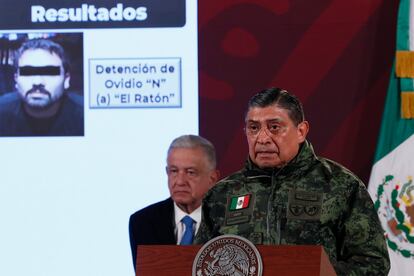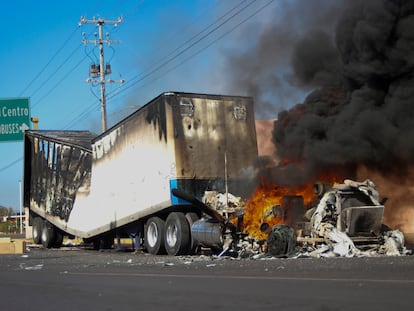The capture of El Chapo’s son: Six months of patience, followed by a bloody battle
Ovidio Guzmán was detained by the Mexican Army in an isolated place, during low traffic hours. Despite all precautions taken, the confrontation left 29 people dead, including 10 soldiers

In 2019, Ovidio Guzmán – the son of drug trafficker Joaquin “El Chapo” Guzmán – was detained and released in Culiacán, the capital of the northwestern Mexican state of Sinaloa. It took more than three years to have a second shot at catching him. He was finally taken into custody by authorities on January 5, 2023.
On Friday, the Mexican government revealed that Guzmán and his gang – Los Chapitos, a faction of the Sinaloa Cartel – had been under surveillance for the past six months. To avoid violent scenes like those from 2019 – when hundreds of his henchmen opened fire and threatened mass civilian deaths to secure their boss’s release – authorities waited patiently for the perfect time to strike.
The cost of human life has still been high: 29 people were killed during the operation, including 10 soldiers. However, Mexican President Andrés Manuel López Obrador and Defense Secretary Luis Crescencio Sandoval made it clear that the effort by investigators and officers had been a resounding success.
The fall of Guzmán – a top priority for the United States – put the 2019 fiasco to rest. López Obrador has explained that extradition to the US will be completed as soon as possible, although he eventually backtracked regarding how fast this could be done. The Mexican Prosecutor’s Office has also opened an investigation against El Chapo’s son, for the crimes committed on Friday: murder and illegal possession of weapons.
Defense Secretary Sandoval implied that Guzmán was found by pure luck, but López Obrador contradicted him, hinting that the authorities waited for Guzmán to be in an isolated place, far from the center of Culiacán, during low traffic hours.
The Mexican president also denied that his security forces received any operational help or intelligence from the United States. However, official sources confirmed to EL PAÍS that both countries had exchanged information to facilitate the capture of Guzmán.

Three years ago, an elite group of soldiers arrived at the criminal leader’s residence in the center of Culiacán. The plan was to quickly detain him and transport him to Mexico City. But Guzmán’s henchmen mobilized, setting up blockades across the city. They then targeted the neighborhood where many military families live. Finally, under threat of a massacre, President López Obrador ordered his officers to release the narco.
At his press conference on Friday, Secretary Sandoval detailed how authorities approached the arrest differently this time around. First, they waited for Guzmán to travel away from the city, keeping all units on high alert.
“Based on October 17, 2019, we reinforced security at military installations,” General Sandoval explained. “We intensified training – we provided ground and air forces, in order to fulfill the main mission.”
The sighting of half-a-dozen suspicious trucks in a regular transit area of Los Chapitos marked the beginning of the operation.
“Six months ago, areas were detected where Ovidio carried out illegal activities, related to methamphetamine and fentanyl trafficking,” Sandoval said. On Thursday, a National Guard patrol stopped the trucks in the town of Jesús María, 30 miles from Culiacán. Its occupants responded with bullets before fleeing. The Guard asked for support from the Army, which launched “the contingency plan and security procedure.” Sandoval has not said whether the patrol sensed that Guzmán was in the trucks.

The vehicles subsequently entered a house in Jesús María, with soldiers and criminals exchanging shots. Los Chapitos, Sandoval said, used – among other weaponry – machine guns and 50-caliber rifles, capable of penetrating armored vehicles. Prohibited weapons in Mexico, their use – like rocket launchers – is increasingly common among criminal groups.
In 2015, alleged members of the Jalisco New Generation Cartel (CJNG) shot down a military helicopter with a rocket launcher. Six soldiers died. The Mexican government has repeatedly insisted that these weapons come from the US market. President López Obrador frequently (and publicly) asks the Biden administration for greater collaboration to prevent arms trafficking.
Secretary Sandoval said that the types of weapons used by the cartel members forced military units to request the intervention of helicopters. This guaranteed the safety of security personnel and discouraged the criminals from trying to rescue their boss.
At least 29 gang members, soldiers and civilians died in the gunfight. Guzmán – finally in custody – was airlifted via military helicopter.
“Simultaneously, cells of the criminal group carried out blockades in Culiacán to prevent the evacuation of Ovidio,” Sandoval narrated. “These [gang members] fired at aircraft of the Mexican Air Force and at commercial lines in Culiacán. Two aircraft that participated in these activities had to make emergency landings, but there were no effects on the personnel, despite the considerable number of hits taken,” he concluded.
Following the arrest of Guzmán, the situation in the city was reminiscent of 2019. Dozens of members of Los Chapitos swept through Culiacán, hijacking vehicles and setting them on fire. The chaos in the city reached other parts of the state of Sinalao, such as Los Mochis, Mazatlán and Escuinapa. In the last municipality, hitmen assassinated an Army colonel, ending a difficult day for the Armed Forces and the entire country.
Sign up for our weekly newsletter to get more English-language news coverage from EL PAÍS USA Edition
Tu suscripción se está usando en otro dispositivo
¿Quieres añadir otro usuario a tu suscripción?
Si continúas leyendo en este dispositivo, no se podrá leer en el otro.
FlechaTu suscripción se está usando en otro dispositivo y solo puedes acceder a EL PAÍS desde un dispositivo a la vez.
Si quieres compartir tu cuenta, cambia tu suscripción a la modalidad Premium, así podrás añadir otro usuario. Cada uno accederá con su propia cuenta de email, lo que os permitirá personalizar vuestra experiencia en EL PAÍS.
¿Tienes una suscripción de empresa? Accede aquí para contratar más cuentas.
En el caso de no saber quién está usando tu cuenta, te recomendamos cambiar tu contraseña aquí.
Si decides continuar compartiendo tu cuenta, este mensaje se mostrará en tu dispositivo y en el de la otra persona que está usando tu cuenta de forma indefinida, afectando a tu experiencia de lectura. Puedes consultar aquí los términos y condiciones de la suscripción digital.
More information
Archived In
Últimas noticias
Maduro pleads not guilty before the federal court in New York: ‘I am still the president of Venezuela’
A new test can detect Alzheimer’s from a finger prick
UN team enters Sudanese city of El Fasher after paramilitary massacre: ‘It’s like a ghost town’
A recipe for resistance: Indigenous peoples politicize their struggles from the kitchen
Most viewed
- Gilles Lipovetsky: ‘If you want to live better and fall in love, take Prozac, don’t look to philosophy’
- Alain Aspect, Nobel laureate in physics: ‘Einstein was so smart that he would have had to recognize quantum entanglement’
- Alvin Hellerstein, a 92-year-old judge appointed by Bill Clinton, to preside over Maduro’s trial in New York
- Why oil has been at the center of Venezuela-US conflicts for decades
- Maduro’s downfall puts China’s relationship with Venezuela to the test











































